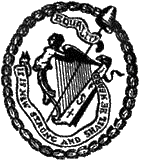
|
Catholic Relief Acts (1771-1793)They were a series of enactments partially dismantling the penal laws. Historians disagree over how far Irish Protestant attitudes to Catholicism changed during the second half of the 18th century: The long period of peace since the Williamite War (1689-91) undoubtedly encouraged greater confidence, and Jacobitism quickly declined after 1745. Yet the execution of Nicholas Sheehy (1766) revealed the continued strength of anti-Catholicism, and patriots remained divided as to how far their rhetoric of liberty extended to the Catholic majority. Recent accounts stress the initiative taken by British government, concerned particularly to tap the large reserve of potential military manpower in Ireland. The revived Catholic Committee further added to pressure for concessions.1 Father Nicholas Sheehy (1728-66), was a Catholic priest executed for murder at Clonmel, County Tipperary. His trial was one of a series launched against local Catholic clergy and gentry at a time when sectarian passions had been inflamed both by the Whiteboy movement and by a bitterly contested by-election (1761) involving the convert Mathew family. Sheehy, who had apparently been active in anti-tithe protest, had surrendered himself following an initial indictment, on the understanding that he would be tried in Dublin. He was acquitted there but then returned to Clonmel, where he was convicted, along with three prominent local Catholics, on highly suspect evidence. Their judicial assassination is widely cited as evidence of the continued strength of anti-Catholicism, and the potential for arbitrary repression, at a time when enforcement of the penal laws was apparently diminishing.2 Early acts releasing the stringency of the penal laws were passed in 1771 and 1774. Bishop Hervey's act of 1774 introduced a new oath of allegiance that prepared the way for change. Bishop Frederick Augustus Hervey (1730-1803), was a Church of Ireland bishop, peer, radical politician, and eccentric. Appointed bishop of Cloyne when his brother, the 2nd earl of Bristol, was briefly lord lieutenant (1766-7), he was translated to Derry in 1768. In 1779 he succeeded his brother as earl. He appeared with great ceremonial at the Volunteer National Convention of 1783, and took a leading part in the proceedings, much to the alarm of Charlemont, who consciously used his position as commander-in-chief to negate Hervey's influence. He was an open supporter of Catholic emancipation, and cultivated good relations with Methodists and Presbyterians in his diocese. A lover of fine art, he spent much of his time in Italy.3 The Relief Act of 1778, introduced by Luke Gardiner but promoted by the government, enabled Catholics who had taken this new oath to bequeath land to a single heir. However MPS rejected Gardiner's proposal to allow the purchase of land. Instead the act permitted Catholics to take leases for up to 999 years, which conferred none of the political rights attached to freehold. 4 Two further measures introduced by Luke Gardiner in 1782 allowed Catholics to buy land, except in parliamentary boroughs, and removed most of the restrictions affecting Catholic education and the Catholic clergy.5 Luke Gardiner (1745-98) who was created Viscount Mountjoy in 1795, was a member of parliament as was his grandfather, for Co. Dublin between 1773-89. His death at the hands of rebels during the insurrection of 1798 was seen by many as a fit return for his sponsorship of the first Catholic Relief Acts in 1778 and 1782. Luke's grandfather also named Luke Gardiner (d. 1755) was a banker and property developer. Grandfather Luke was involved in urban building projects from as early as 1712. In the 1740s and 1750s he was responsible, with his son Charles, for the development of a large area of what became central Dublin. O'Connell Street, constructed in the 1740s, was originally called Gardiner's Mall. He further enhanced his fortune by holding the lucrative office of deputy vice- treasurer, which allowed him temporarily to invest official balances on his own account.6 Following the French Revolution British government looked to further relief legislation to prevent any alliance between Catholics and radical Presbyterians. Sir Hercules Langrishe's act of 1792 allowed Catholics to practise law. Following continued pressure from the Catholic Committee, an act of 1793, introduced by Chief Secretary Robert Hobart and forced through by government influence, gave Catholics the right to vote and to hold most civil and military offices. The violent anti-Catholic rhetoric of the bill's opponents and the resentment of Protestants at this perceived betrayal by British government, contributed significantly to the growth of religious conflict. 7 After 1793 Catholics were still barred from sitting in parliament, from the offices of lord lieutenant, chief secretary, chancellor of the exchequer, and from other senior political positions. They could not be king's counsel, judges or governors, sheriffs or sub-sheriffs, and could not hold higher military rank than colonel. Hopes for further relief were briefly raised under Fitzwilliam, and again at the time of the Act of Union. But it was not until 1829 that the last Catholic Relief Act removed these remaining disabilities.8 Footnotes
Reference Thomas Bartlett, The Fall and Rise of the Irish Nation (1992). |